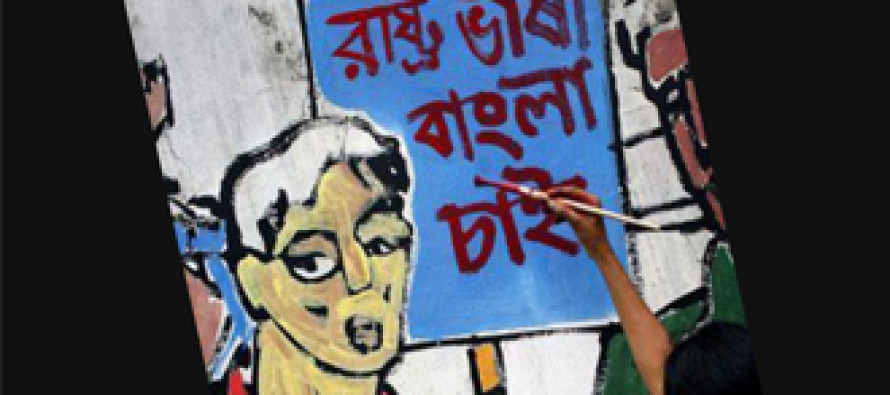Towards 1952

Between August 1947 and 21 February 1952
Independence of Pakistan in 1947 and Bangla language movement in 1952 – what actually happened in between? Why within those five year’s, people were ready to sacrifice lives for their language, for their ‘maayer vasha’, for their self-respect? What were the actions, triggered such sad but proud moment? This is ‘towards 1952’, story of the Bangla language movement between 1947 and 1952.
The newly born Pakistan had two wings, West Pakistan and East Bengal (from 1956, East Pakistan, today Bangladesh). When the English rulers left the sub-continent in 1947, they never wanted to use the ‘national’ language of this land as any negotiation point. They never negotiated ‘officially’ that English should be the language of this land. They did understand the sensitivity and the connections between the language, land and the people. What they did is, very cleverly ‘merged’ us into a formal education system that made us English literate and ‘knowing English’ gave us a symbol of ‘status’. One of the most effective and strategic move undertook by the British Monarch rather than ‘rocking the boat’ by threatening the pride of our languages! Majority of the people of former Pakistan, were very passionate about their language. They had a dream that one day they will have every right to use their mother language as the national language. For thousands of years, they expressed their happiness, sadness, love, patriotism, passion and cultural aspirations in that language. The language, which was sweeter than the best singing birds; had the courage to tell the truth; had the determination eventually led to the freedom of those people.
Yes, this is the story of Bangla – our mother language and the beginning of the language movement. Unfortunately, the journey of Bangla to become the national language for this country was not that smooth. Unlike the ‘cunning’ British monarch, one day the ‘King’ of the new country asked the people to ‘speak’ in a different language! He ordered them to respect a different language as their key communication tools, told them to adopt that language as their national language, which was spoken by only 7.5% population of that country! This was the beginning of a challenging journey for the Bangla speaking people to establish their mother language as the national language.
I would like you to travel with me from that time of the last century to an independent Bangladesh, a living demonstration of pride, courage, determination and collective strength. This is a compilation of historic pieces gathered from different researchers work over last few decades. Let’s go to the late 1940s and early 1950s in the than East Pakistan to explore the courageous and inspirational history towards 1952.
Journey Part One: prior 1947
The language controversy in Pakistan started even before its independence. Dr Ziauddin Ahmed, the than Vice Chancellor of Aligarh University, suggested that Urdu should be the state language of the future state of Pakistan. Dr Md Shahidullah, the famous Bengali professor of linguistics, objected very strongly and wrote ,
“If Urdu or Hindi instead of Bengali is used in our law courts and universities,
that would be a demonstration of political slavery”
This was the beginning of language controversy in the than Pakistan.
Journey Part Two: 1947-48
Pakistan and India became independent in 1947. It was 23 February 1948, Mr Dhirendra Nath Dutta, a member of the than Pakistani assembly, as part of an amendment on the rules of procedures of the than Assembly recommending to give Bangla equal status along with Urdu and English as the state language of Pakistan told the House ,
“Bengali is a provisional language but so far as our state is concerned, it is the language of the majority of the people of the state…..Out of sixty nine million people in Pakistan, fourty-four million people speak the Bengali language … I am voicing the sentiments of the vast millions of our state, and therefore Bengali should not be treated as a provisional language. It should be treated as the language of the state.”
Mr Liaqat Ali Khan, the than Prime Minister of Pakistan, was the first one to oppose this proposal. He stated ,
“Pakistan has been created because of the demand of a hundred million Muslims in this sub-continent
and the language of the hundred million Muslims is Urdu… Pakistan is a Muslim state
and it must have as its lingua franca the language of the Muslim nation.”
This language policy of the Pakistani government was strongly objected by the Bangla speaking population of the former East Pakistan. In fact, the students in Dhaka city observed a protest strike on 26 February 1948. They formed the All Party State Language Committee of Action and observed another strike on 11 March 1948. This is when, for the first time, Police used forces including tear gas and sticks. Around thousand ‘protestors’ were arrested and thrown into the prison. However, the protestors continued their strike until the Chief Minister of the East Bengal, Khawaja Nazimuddin, signed an eight-point agreement with the leaders of the Committee of Action on 15 March 1948. The two most significant clauses were:
1. In the April (1948) session of the East Bengal Legislative Assembly a special resolution will be moved to propose to the constituent assembly of Pakistan to make Bengali as one of the state languages of Pakistan and give Bengali the same status with Urdu in the competitive examinations of the central services of Pakistan;
2. In the month of April (1948) another resolution will be moved in the East Bengal Legislative Assembly to make Bengali as the official language of the province of East Bengal in place of English. Beside that Bengali will be the medium of instruction .
Chief Minister Khawaja Nazimuddin, contrary to his earlier commitment to the eight point plan signed with the Committee of Action, moved the following resolutions in the East Bengal Legislative Assembly on 8 April 1948.
• Bengali shall be adopted as the official language for replacing English in the province of East Bengal and it will be implemented as soon as the practical difficulties are resolved;
• The medium of instruction in educational institutions in East Bengal shall, as far as possible, be Bengali, or the mother tongue of the majority of scholars in the institutions.
This ‘diluted’ version directly impacted the expectations of the people of East Bengal as it failed to recognise their ethnic and cultural diversity. They criticised the Muslim League, the leaders of Pakistan, for not accepting the reality that Pakistan was a multilingual and multi-national state. Around the same time, in the height of this civic unrest, Governor-General of Pakistan Muhammad Ali Jinnah arrived in Dhaka on 19 March 1948. On 21 March, at a civic reception at Racecourse Ground (currently Suhrawardy Uddyan), he declared that Urdu would be the only official language for both the West Pakistan and East Bengal. He said ,
“Let me make it very clear to you that the state language of Pakistan is going to be Urdu and no other language. Anyone who tries to mislead you is really the enemy of Pakistan. Without one state language, no nation can remain tied up solidly together and function. Look at the history of other countries. Therefore, so far as the state language is concerned, Pakistan’s shall be Urdu.”
Jinnah reiterated the same message in his famous convocation address at the Curzon Hall of University of Dhaka, on 24 March 1948. He said,
“Make no mistake about it. There can be only one State language, if the component parts of the State are to march forward in unison and that language, in my opinion, can only be Urdu.”
Another significant ‘triggering point’ of the 1948 was the “Arabicization of Bangla” by the than Government of Pakistan. On 27 December 1948, the education minister of Pakistan, Fazlur Rahman, suggested to the All Pakistan Education Conference that old and traditional scripts or writing systems – which included Bangla – should be changed to Arabic or Urdu script “for the sake of Islam” .
Journey Part Three: 1949-50
On 7 February 1949, the Central Pakistan Education Advisory Board strongly recommended the Arabic script as the only script for all Pakistani languages. The other West Pakistani languages such as Punjabi, Sindhi, Baluchi and Pashtu were written in Arabic script which Urdu and Persian languages both adopted. Bangla or Bengali as most call it, by contrast, had its own script different from that of Arabic or Devanagri script. In response to this proposed action, Professor Rafiqul Islam stated ,
“The attempt of introducing Arabic script for the Bengali language, which has a rich heritage and tradition, is an attack on our language, literature and culture. This attempt has created a fear of new colonial design and slavery in the minds of Bengalis.”
The students of Dhaka University launched a protest memorandum to the Education Advisory Board. On 27 November 1948, Dhaka University Central Student’s Union presented a historic memorandum to the Prime Minister of Pakistan at the Dhaka University gymnasium ground on behalf of all the students demanding Bangla to be the state language. Despite the protest, the Pakistan Government commenced the initiative with at least 20 adult education centres in different parts of the former East Pakistan with the intention of teaching Bangla through Arabic script. They were actively supported by East Bengal government, which set up a committee on 9 March 1949 to bring about this linguistic reform.
The Pakistanis recommended that the “Sanskritization of the language be avoided “, removal of Sanskrit principles from Bangla grammar, and the introduction of Urdu as a second language in the secondary and higher stage of education to make the linguistic, social, political and cultural “bonds” between the two wings of Pakistan “closer and deeper”. Just after this, the East Bengal Language Committee was formed by the East Bengal Government to prepare a report on the language problem under the leadership of Maulana Akram Khan. The Committee completed its report on 6 December 1950, but it was not published until 1958. The government suggested that Bengali be written in Arabic script, as a potential solution to the language conflict .
Instead of taking steps to calm the anger, the Pakistani Government moved to edit the style and diction of the Bengali language by publishing a report in 1950 saying that Sanskrit words from Bengali were to be strictly avoided and Urdu, Arabic or Persian words were to be replaced with them. But Bengali like other Indo-Aryan languages had incorporated large numbers of Sanskrit or old Indo-Aryan words in the course of its thousand years of evolution and it would have been impossible to undo this historical process. The East Bengal language committee also suggested drastic modifications of the Bengali writing system and issued a model chart as a guide. The East Bengal population again protested against this.
Journey Part Four: 1951-52
On 26 January 1952, the then Prime Minister of Pakistan Khawaja Nazimuddin again announced that Urdu would be the national language of all Pakistan. This announcement triggered the final ‘protest’ and the language movement reached at its final stage. February 21st was declared as the state language day for former East Pakistan. On 21 February 1952, (8th Falgun 1358 in the Bengali calendar), students in the capital city of Dhaka called for a provincial strike.
In response to this the Pakistani Government banned all meetings, processions and demonstration against government’s decision. The students of Dhaka University defied the bans! The government invoked a limited curfew to prevent this and the protests were tamed down so as to not break the curfew. The students brought out massive protest demonstrations, which created a direct clash between them and the Government. It was like a ‘one sided’ war field! The police and para-military inspired by the Pakistani Government started to throw tear-gas to the demonstrator and finally started to fire bullets at them. Ultimately with this one-sided cowardly attack, a lot of students were killed, hundreds were injured and thousands were arrested. The Pakistani police fired on the students despite these peaceful protests and a number of students and other people were killed. Four of the students were Abdus Salam, Rafiq Uddin Ahmed, Abul Barkat and Abdul Jabbar.
But the language movement did not stop!
The First Shaheed Minar
The first Shaheed Minar to commemorate the loss of people’s lives on 21 February, was built immediately after the events of February 21, 1952. This first Shaheed Minar, built on February 22, 1952. According to Dr. Sayeed Haider, a main planner and the designer of the first Shaheed Minar, the decision to build was first made by the students of Dhaka Medical College. The planning started at midnight on February 22, and the work started the next day. Pearu Sardar, one of the old Dhaka panchayet sardars, sponsored this Minar. He extended his support when some of the students asked his help at midnight of 22 February, to contribute the raw materials needed to build the monument. Although curfew was in place, students started building the Minar in the afternoon of February 23. They worked through the night and finished it at dawn. A hand written paper was attached to the Minar with “Shaheed Smritistombho” written on it. Unfortunately, four days later, Pakistan Police and Army demolished it. But smaller versions of the memorial were built in other places of the country.
Journey Part Five: 1953-71
Two years after the police destroyed the first monument; a new Shaheed Minar (Monument of Martyrs) was constructed in 1954 to commemorate the protesters who lost their lives. Work on a larger monument designed by the Hamidur Rahman began in 1957. 1958, when martial law was declared in Pakistan, the construction was forced to a halt but was completed in 1963. The mother of Abul Barkat, Hasina Begum, inaugurated the new Minar on February 21, 1963. Again, the minar was severely damaged by the Pakistan Army during the Bangladesh Liberation War in 1971. The columns were destroyed during the fighting. The Pakistani Army crushed the minar and placed a signboard over the rubble reading “Mosque”. It was rebuilt after 1971 when a new country Bangladesh was born, with its own language Bengali as the national language.
Epilogue
It took another 28 years, since 1971, for the whole world to acknowledge the extreme sacrifice that a nation did to establish their mother tongue as the national language. On 17 November 1999, UNESCO announced to observe International Mother Language Day annually on 21 February worldwide to promote awareness of linguistic and cultural diversity and multilingualism.
The day is revered in Bangladesh and, to a somewhat lesser extent, in West Bengal as the Martyrs’ Day. To promote linguistic and cultural diversity and multilingualism many cities of the world already established ‘Mother Language Monument’ with different names. Tokyo built a replica of original monument of Bangladesh (Shaheed Minar), Monuments are built in Ashfield Park Sydney, London and Oldham in the United Kingdom, Bari of Italy and Surrey of Canada and few other cities. This February, New York City, USA inaugurated the first sculpture representing the language movement in Bangladesh. Australian multilingual community have commenced the International Mother Language Movement (IMLM) to signify the importance of mother languages spoken in Australia including the long lost languages of the Australian Aborigines and ways to preserve them.
What started in 1952, is now a global phenomenon, a global movement, a global sensation – and the credit goes to the people who were alive and vocal during the period between 1940’s and 1950’s – the Bangla speaking community.
Farhadur Reza, Architect-Planner and Optimist.
Footnotes:
Shahidullah 1947: 34-35.
Constitutional Assembly of Pakistan Proceedings 1948: 15-16.
Constitutional Assembly of Pakistan Proceedings 1948: 17.
Omar 1970: 81.
Muhammad Ali Jinnah in a public meeting at the Race Course Maidan, Dhaka, on 21 March 1948
http://www.londoni.co/index.php/history-of-bangladesh
Rafiqul Islam’s contribution in “Language and Civilization Change in South Asia” (1978)
http://books.google.co.uk/books?hl=en&lr=&id=M_oUAAAAIAAJ&oi=fnd&pg=PA142&dq=bangladesh+language+movement&ots=KMsIBgbbek&sig=anG7W_28oEKgHeNZOOFbSADYVZg#v=onepage&q&f=false
http://www.londoni.co/index.php/history-of-bangladesh
Related Articles
জীবন
আমাদের জীবনটা ভারি অদ্ভুত, কখন কি হবে কেও জানেনা, এমনকি আভাসও পায়না, এক নিমেষে সব কিছু উল্টায় যায়…ভাল বা খারাপ!
ভোজনানন্দ ও এশার ঈদ
ভেজিটেবল লাজানিয়ার ডিশভোজনানন্দ শব্দটি দেখে কেউ ভুল করেও যেন ভাববেন না যে এটি কোনো ব্যক্তির নাম। কেউ যদি মনে
Bipod Aashche Bipod!
বিপদ আসছে বিপদ! -ড.ফরিদ আহমেদ বাংলাদেশ যা ছিল এক সময়ে স্বপ্নের দেশ সেটি এখন চরম সামাজিক নিরাপত্তার হুমকিতে। ১৯৪৭ সালে






